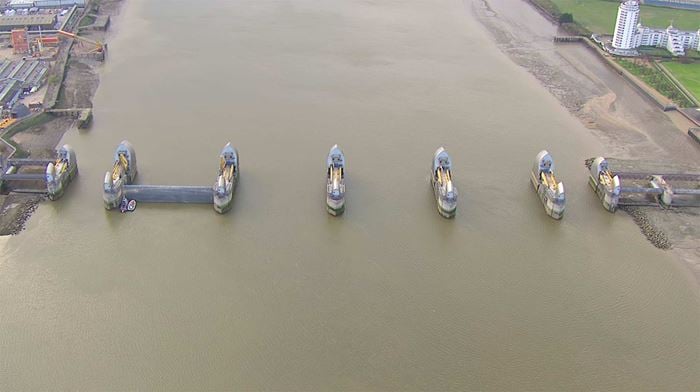Nothing has greater potential to reshape the lives of billions as much as climate change, and whilst leadership from national government is vital, the greatest opportunity to positively influence climate action is by transforming the built environment. Arup was founded on a belief of doing work which leaves a positive legacy for subsequent generations and this consequently feeds into our unique perspective on climate change.
We have identified four key areas that are of strategic importance to our clients. Our cities, transport, energy and water resources are all under immense pressure due to rapid urbanisation, improved mobility, rising energy demand and water scarcity. By addressing these challenges together with our clients we will play an important part in mitigating the impacts of climate change.
Collaborative action between the public and private sector can positively improve our environmental performance. We bring together experts in engineering, planning, development, finance, design and operations to advise governments, mayors, developers, investors, communities and businesses on the most effective strategies to address the impact of climate change through the built environment.
As a firm, we're working with our clients on:
-
Collaboration and partnership
-
Resilience and adaptation
-
Transitional energy sources
Collaboration and partnership
Arup’s global reach and reputation provides us the privileged opportunity to promote open dialogue and best practice sharing amongst those with the power to influence the world’s approach to climate change.
We are actively encouraging collaboration and partnership on every continent. For example, we have committed $1 million of professional support to the C40 Cities Climate Leadership Group – 82 cities dedicated to addressing climate change. As a result, we have gained unparalleled insights and crucial data to help cities deliver effective climate change strategies.
Michael Bloomberg, the UN Special Envoy on Cities and Climate Change, asked us to assess how cities are working together on their city climate initiatives. The research estimates that cumulative emissions savings by cities could reach 13 GtCO2e by 2050 – equivalent to the combined annual emissions of China and India. That’s how valuable collaboration and sharing can be.
Cities need practical tools to battle climate change. So, working with the Rockefeller Foundation, we have developed the City Resilience Index comprising evidence and knowledge, from more than 150 sources, including 14 city case studies and the output from fieldwork in six cities. The Framework enables cities to understand their resilience, shape urban planning and choose appropriate investments.
Similarly, Arup and The Open Data Institute (ODI), an independent, non-profit, non-partisan body founded to inspire innovation with data, has brought together public, private and academic experts to design, share and use information about cities which prioritises the needs of people and the imperative of climate change. (The ODI was founded by Sir Tim Berners-Lee and Nigel Shadbolt).
Resilience and adaptation
A changing climate poses a critical challenge to how we improve our cities’ resiliency and adapt our buildings and infrastructure. Our technical expertise, combined with an in-depth understanding of the built environment, enables us to help a wide range of clients address the impacts of climate change.
New construction techniques, alternative materials and innovative technologies enable us to retrofit old, and design new, buildings and structures to withstand the current and predicted impacts of climate change.
Following the devastating earthquake in 2011, we’ve worked with the city of Christchurch, New Zealand, on the ‘Sensing City’ project to embed sensors into the city’s infrastructure – such as roads, energy and water systems – to collect valuable data on the environmental stresses these assets endure on a daily basis. It means we can respond to changes which are occurring, before the strains become critical.
We are also re-thinking our approach to designing infrastructure. In the UK, we’re working with Leeds City Council on installing innovative moveable weirs as part of a critical Flood Alleviation Scheme to protect the city. Knowledge such as this can be shared through the Flood Hazard Assessment and Adaptation Toolkits we’ve devised for cities facing sea level rise and increased flood risk.
Elsewhere in the world, we’re introducing clients to new technologies and techniques, such as using bio-facades to produce biomass energy and capture solar thermal heat, and concepts such as vertical farming and urban foraging, which could boost food production and natural resources. And we’re encouraging strategic and intelligent use of renewable materials, such as timber, and reclaimed materials on built environment projects.
Shared problems call for shared solutions. We’re helping to make the business case by looking at the economics of resilience so our clients can justify their investment in climate action.
Climate Action in Megacities (CAM 3.0)
Climate Action in Megacities (CAM 3.0) looks at how the world’s greatest cities are forging a pathway to low carbon and climate resilient development, recognising climate risks and taking more action on climate adaptation, as well as mitigation.
Download
Transitional energy sources
The energy trilemma – how to balance sustainability, cost and security of supply – is on the minds of city leaders around the world. The solution is a strategy based on a broad energy mix of lower carbon sources whilst we develop low-carbon renewable alternatives.
Developing a strategy to tackle the trilemma, and meet our carbon emission targets to limit global warming, requires a balanced and collaborative approach. In response, we work with our clients to help meet their energy and carbon challenges by drawing on relevant, real-world expertise in financial modelling, energy, infrastructure and more.
Our renewable energy centre of excellence in South Africa is helping secure a reliable and sustainable alternative to the ageing coal-based generating capacity the country has relied on until now. We’ve advised on the development of the 75MW Kalkbult photovoltaic (PV) plant, the 73.8MW Nobelsfontein wind farm and the Rosherville research facility (the first of its kind in Africa). In Hong Kong our expertise led to our design team developing a self-sufficient and sustainable solution to dispose of up to 2,000 tonnes of sewage sludge per day in the largest incinerator of its type in the world. The heat generated is recovered for power generation, and power surplus to the plant’s requirements is exported to the regional electricity grid. We’ve helped realise over 100GW of geothermal power in countries including Australia, China, Nigeria and Colombia.
In Europe, we’ve conducted a study looking at the CO2 generated by infrastructure to plan future Carbon Capture & Storage (CCS) facilities across Europe. CCS is one of the only technologies capable of mitigating greenhouse gas emissions from large-scale fossil fuel usage, so it has the potential to solve the energy crisis in an environmentally acceptable way.
More broadly, low-carbon energy solutions such as wind, solar, geothermal, hydro, marine and nuclear power, zero net energy schemes, microgrids and district heating all have a part to play in addressing the energy trilemma. At Arup, we work with leading organisations and academics to ensure that we are at the forefront of the research and development of transitional and renewable energy sources.
 ;
;




